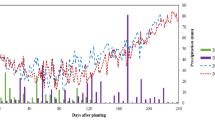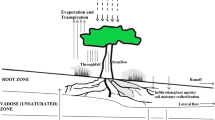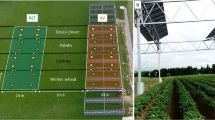Abstract
Crop irrigation with subsurface drip (SDI) is increasing in the semiarid Texas High Plains (THP). Information on drip-tubing positioning, irrigation strategies, and wetted soil area is needed to increase rainwater effectiveness when well capacities are inadequate to meet full irrigation requirements. Time and resources necessary to test SDI strategies for different conditions through field experimentation is too large. However, a mechanistic model such as Hydrus-2D can quantify the effect of different installation geometries and irrigation strategies. Our objective was to experimentally validate the Hydrus-2D in an Amarillo soil in THP so that the model can be used to evaluate different irrigation frequency and timing strategies for SDI cotton. Results showed that Hydrus-2D simulated volumetric soil water content within ±3% of measured values, and simulation bias represented the smaller portion of the simulation error, indicating that the model can be used to evaluate irrigation strategies.








Similar content being viewed by others
Notes
Mention of this or other proprietary products is for the convenience of the readers only, and does not constitute endorsement or preferential treatment of these products by USDA-ARS.
References
Allen RG, Pereira LS, Raes D, Smith M (1998) Crop evapotranspiration, guidelines for computing crop water requirements. FAO irrigation and drainage paper 56, Food and Agriculture Organization of the United Nations (FAO), Rome
Ball RA, Oosterhuis DM, Mauromoustakos A (1994) Growth dynamics of the cotton plant during water-deficit stress. Agron J 86:788–795
Baumhardt RL, Lascano RJ, Krieg DR (1995) Physical and hydraulic properties of a Pullman and Amarillo soil on the Texas South Plains. TAES/TAMU/College Station, Texas. Technical report no. 95–1, 17 pp
Bhattarai SP, McHugh AD, Lotz G, Midmore DJ (2006) The response of cotton to subsurface drip and furrow irrigation in a vertisol. Exp Agric 42:29–39
Bordovsky JP, Lyle WM (1996) Protocol for soil water depletion of irrigated cotton. In: Camp CR et al (ed) Evapotranspiration and irrigation scheduling. Proceedings of the international conference, San Antonio, TX, 3–6 Nov 1996, ASAE, ST Joseph, MI, pp 201–206
Bordovsky JP, Lyle WM, Lascano RJ, Upchurch DR (1992) Cotton irrigation management with LEPA systems. Trans ASAE 35:879–884
Camp CR (1998) Subsurface drip irrigation: a review. Trans ASAE 41:1353–1367
Colaizzi PD, Gowda PH, Marek TH, Porter DO (2008) Irrigation in the Texas High Plains: a brief history and potential reductions in demand. Irrig Drain 58:257–274
English M (1990) Deficit irrigation I—analytical framework. J Irrig Drain Eng 116:399–412
Evett SR, Heng LK, Moutonnet P, Nguyen ML (2008) Field estimation of soil water content: a practical guide to methods, instrumentation and sensor technology. IAEA-TCS-30. International Atomic Energy Agency, Vienna. ISSN 1018-5518, 131 pp
Fereres E, Soriano MA (2007) Deficit irrigation for reducing agricultural water use. J Exp Bot 58:147–159
Gee GW, Bauder JW (1986) Particle-size analysis. In: Klute A (ed) Methods of soil analysis, Part 1, 2nd edn. Agronomica monograph 9, ASA and SSSA, Madison, pp 383–411
Gitz D, McMichael BL, Mahan J, Lascano RJ (2006) Effect of alternate-row drip irrigation pattern on cotton root distribution. In: Proceedings of the Beltwide cotton conference, San Antonio, TX, 3–6 Jan 2006. [CD-ROM] National Cotton Council of America, Memphis
Ham JM, Heilman JL, Lascano RJ (1991) Soil and canopy energy balances of a row crop with incomplete cover. Agron J 83:744–753
Howell TA, Yazar A, Schneider AD, Dusek DA, Copeland KS (1995) Yield and water use efficiency of corn in response to LEPA irrigation. Trans ASAE 38:1737–1747
Howell TA, Evett SR, Tolk JA, Schneider AD (2004) Evapotranspiration of full-, deficit-irrigated, and dryland cotton on the northern Texas High Plains. J Irrig Drain Eng 130:227–285
Kandelous MM, Šimünek J, Van Genuchten M, Malek K (2010) Evaluation of soil water content distribution in the subsurface drip irrigation system: field measurement and numerical simulation. Poster 300-7 presented at the ASA, CSSA and SSSA 2010 international annual meetings, Long Beach, Oct 31–Nov 3
Klute A, Dirksen C (1986) Hydraulic conductivity and diffusivity: laboratory methods. In: Klute A (ed) Methods of soil analysis, Part 1, 2nd edn. Agronomica monograph 9, ASA and SSSA, Madison, pp 687–734
Kobayashi K, Salam MU (2000) Comparing simulated and measured values using mean squared deviation and its components. Agron J 92:345–352
Kromm DE, White SE (1992) Groundwater exploitation in the High Plains. University Press of Kansas, Kansas
Lascano RJ (2000) A general system to measure and calculate daily crop water use. Agron J 92:821–832
Lascano RJ, Van Bavel CHM (1984) Root water uptake and soil water distribution: test on an availability concept. Soil Sci Soc Am J 48:233–237
Lascano RJ, Koster A, Booker, JD, Gitz D, Mahan JR, McMichael BL, Wanjura DF (2006) Rainfall use by cotton irrigated with buried drip. In: Proceedings of the Beltwide cotton conference, San Antonio, 3–6 Jan 2006
Lyle WM, Bordovsky JP (1981) Low energy precision application (LEPA) irrigation system. Trans ASAE 24:1241–1245
Lyle WM, Bordovsky JP (1995) LEPA corn irrigation with limited water supplies. Trans ASAE 38:445–462
Moriasi DN, Arnold JG, van Liew MW, Bingner RL, Harmel RD, Veith TL (2007) Model evaluation guidelines for systematic quantification of accuracy in watershed simulations. Trans ASABE 50:885–900
National Climatic Data Center (1999) US monthly precipitation for cooperative and NWS sites. NCDC, Federal building, 151 Patton, Avenue, Asheville, NC 28801–5001, USA
Plaut Z, Carmi A, Grava A (1996) Cotton root and shoot responses to subsurface drip irrigation and partial wetting of the upper soil profile. Irrig Sci 16:107–113
Radcliffe DE, Šimünek J (2010) Soil physics with HYDRUS modeling and applications. CRC Press, Taylor & Francis Group, Boca Raton
Richards LA (1942) A pressure-membrane extraction apparatus for soil solutions. Soil Sci 53:241–248
Sakuratani T (1981) A heat balance method for measuring water flux in the stem of intact plants. J Agric Meteorol 37:9–17
SAS Institute (1988) SAS/STAT user’s guide, 6.03 ed. SAS Inst, Cary
Schaap MG, Leij FJ, Van Genuchten MT (2001) Rosetta: a computer program for estimating soil hydraulic parameters with hierarchical pedotransfer functions. J Hydrol 251:163–176
Schwartz RC, Evett SR, Pelletier MG, Bell JM (2009a) Complex permittivity model for time domain reflectometry soil water content sensing: I. Theory. Soil Sci Soc Am J 73:886–897
Schwartz RC, Evett SR, Bell JM (2009b) Complex permittivity model for time domain reflectometry soil water content sensing: II. Calibration. Soil Sci Soc Am J 73:898–909
Shepard D (1968) A two-dimensional interpolation function for irregularly-spaced data. Proceedings of the 23rd National Conference of ACM, pp 517–524
Šimünek J, Šejna M, van Genuchten MT (1999) The Hydrus-2D software package for simulating the two-dimensional movement of water, heat, and multiple solutes in variably-saturated media. IGWMC-TPS 53-251, Version 2.0, International Ground Water Modeling Center, Colorado School of Mines, Golden
Šimünek J, van Genuchten MT, Šejna M (2006) The HYDRUS software package for simulating the two- and three-dimensional movement of water, heat, and multiple solutes in variably-saturated media. Technical manual, Version 1.0, PC Progress, Prague
Skaggs TH, Trout TJ, Šimünek J, Shouse PJ (2004) Comparison of Hydrus-2D simulations of drip irrigation with experimental observations. J Irrig Drain Eng 130:304–310
Skaggs TH, Trout TJ, Rothfuss Y (2010) Drip irrigation water distribution patterns: effects of emitter rate, pulsing, and antecedent water. Soil Sci Soc Am J 74:1886–1896
Soil Survey Division Staff (1993) Soil survey manual. USDA Agric. Handbook. 18. US Government Printing Office, Washington, DC
Stakman WP, Walk GV, van der Herst GG (1969) Determination of soil moisture retention curves: 1. Sandbox Apparatus, ICW Wageningen
Taylor JR (1999) An introduction to error analysis: the study of uncertainties in physical measurements. University Science Books, Sausalito
Taylor HM, Klepper B (1974) Water relations of cotton. I. Root growth and water use as related to top growth and soil water content. Agron J 66:584–588
Texas Water Development Board (1996) Surveys of irrigation in Texas 1958, 1964, 1969, 1974, 1979, 1984, 1989 and 1994. Report 347, Texas Water Development Board, Austin
Tolk JA, Howell TA (2001) Measured and simulated evapotranspiration of grain sorghum with full and limited irrigation in three High Plains soils. Trans ASAE 44:1553–1558
Topp GC, Davis JL, Annan AP (1980) Electromagnetic determination of soil water content: measurements in coaxial transmission lines. Water Resour Res 16:574–582
Upchurch DR, Wanjura DF, Burke JJ, Mahan JR (1996) Biologically-identified optimal temperature interactive console (BIOTIC) for managing irrigation. US Patent 5,539,637, 23 July 1996
Van Genuchten MT (1980) A closed-form equation for predicting the hydraulic conductivity of unsaturated soils. Soil Sci Soc Am J 44:892–898
Wanjura DF, Upchurch DR (1997) Accounting for humidity in canopy temperature-controlled irrigation scheduling. Agric Water Manage 34:217–231
Wanjura DF, Upchurch DR, Mahan JR (1995) Control of irrigation scheduling using temperature–time thresholds. Trans ASAE 38:403–409
Wanjura DF, Upchurch DR, Mahan JR, Burke JJ (2002) Cotton yield and applied water relationships under drip irrigation. Agric Water Manage 55:217–317
Acknowledgments
This research was supported in part by the Ogallala Aquifer Program, a consortium between USDA-ARS, Kansas State University, Texas AgriLife Research, Texas AgriLife Extension Service, Texas Tech University and West Texas A&M University.
Author information
Authors and Affiliations
Corresponding author
Additional information
Communicated by J. Ayars.
Rights and permissions
About this article
Cite this article
Bufon, V.B., Lascano, R.J., Bednarz, C. et al. Soil water content on drip irrigated cotton: comparison of measured and simulated values obtained with the Hydrus 2-D model. Irrig Sci 30, 259–273 (2012). https://doi.org/10.1007/s00271-011-0279-z
Received:
Accepted:
Published:
Issue Date:
DOI: https://doi.org/10.1007/s00271-011-0279-z




